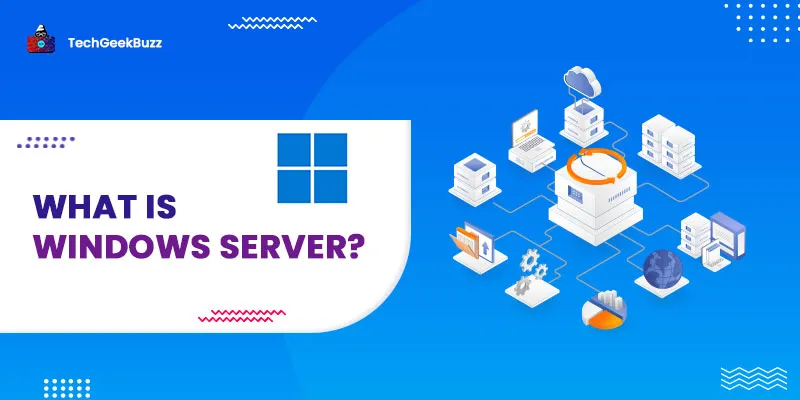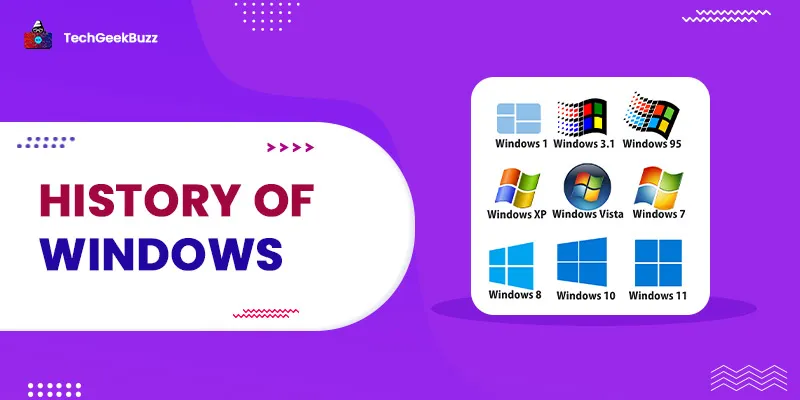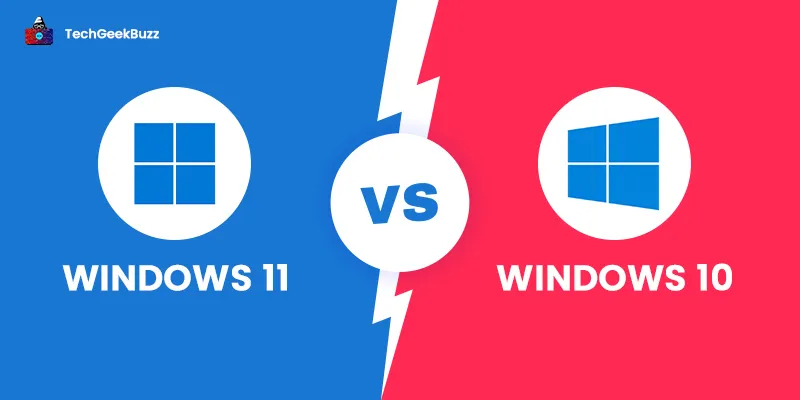We are all familiar with Microsoft Windows. Often referred to as Windows, it is the most popular operating system for desktop PCs. It is one of the most popular graphical operating systems developed by Microsoft. This OS allows storing files, playing video games, running various software, watching videos, and connecting to the internet. Windows Server is its specialized version of the popular operating system for server use, which we are going to discuss in this blog.
Microsoft released the first version of Windows, i.e., version 1.0, in November 1983. After that, the company released multiple versions, and the latest version of the popular operating system is Windows 11, released in October 2021.
Windows Server is yet another well-known product of Microsoft, but many individuals get confused between the two operating systems. Your desktop will appear the same with either of them. This is because they both share the same codebase. However, there are many differences between them.
Through this article, we shall introduce you to the popular Windows OS for servers, along with its history and key features. Also, we shall make you familiar with the differences between Windows Server and Windows.
So, let us get started!
What is Windows Server?
Before we proceed to the actual definition of Windows Server, let us first understand what a server operating system is.
A server operating system is an OS that needs to be installed and used on a system that acts as a server. It is an advanced version of a standard operating system, and it provides services to multiple clients at the same time. It is a group of enterprise-level server operating systems that supports data storage and management of applications and communications.
Microsoft has been developing operating systems for servers since 2003, and Windows Server is the brand name for all those operating systems. The tech giant released the first server operating system - Server 2003 - in April 2003.
However, before it, Microsoft developed the Windows NT 3.1 Advanced Server edition. Also, the company developed Windows 2000 Server edition, which was the first edition to incorporate DHCP Server, DNS Server, Active Directory, and Group Policy.
History
The history of Microsoft’s operating systems for servers started with the release of Windows NT. There were four versions of Windows NT, as follows:
- 3.1 Advanced Server
- 3.5 Server
- Server 3.51
- Server 4.0
After Windows NT, came Windows 2000. In 2003, with the release of Server 2003, Microsoft introduced the brand name for its range of operating systems for servers called, Windows Server.
-
Windows Server 2003
It is the first version of Microsoft’s server operating system that was released in April 2003. Also, it is a part of the Windows NT family of operating systems and successor or follow-up to Windows 2000. It included security improvements over its predecessor. Moreover, Microsoft introduced various server roles that allow administrators to assign a particular function to a server, such as a DNS server or domain controller.
-
Windows Server 2003 R2
R2 stands for Release 2. Instead of using the version number, Microsoft started using R2 for the second release of Server 2003. It is an improved version of Server 2003.
Some major features in this release are Active Directory Federation Services and Active Directory Application Mode. Moreover, it added improvements to file replication and data compression. This version also introduced Security Configuration Wizard, where administrators can change the server’s default security settings.
-
Windows Server 2008
In 2008, the company released Server 2008 with various new features, including failover clustering, Hyper-V virtualization software, server manager console, server core, disk management and file storage, and event viewer.
This version comes in four different editions, namely Standard, Enterprise, Datacenter, and Web.
-
Windows Server 2008 R2
Microsoft introduced the second release of Server 2008 in 2009. In this version, Microsoft improved the Active Directory for managing user accounts with ease. They also upgraded Terminal Services functionality and named it Remote Desktop Services (RDS).
Moreover, this version incorporated new features, such as BranchCache and DirectAccess. Both these features intend to help users get their work done from remote locations.
-
Windows Server 2012
The year 2012 witnessed the release of Server 2012. This version primarily included cloud-related features to make it easy for organizations to run services in public or private clouds. In addition, this release saw a significant update to the storage infrastructure of the operating system and Hyper-V virtualization platform.
Other new features in this version were Hyper-V Replica, Hyper-V virtual switch, ReFS file system, and Storage Spaces. There were four different editions of this version, namely Essentials, Foundation, Standard, and Datacenter.
-
Windows Server 2012 R2
Microsoft introduced the second release of Server 2012 in 2013. This release witnessed updates to various existing features, such as storage, virtualization, networking, web services, and information security.
Some new notable features included in this version were:
-
- Desired State Configuration (DSC) to maintain consistency across all the machines of an organization and prevent configuration drift.
- Storage tiering to Storage Spaces moves frequently called data blocks to SSD and boosts performance.
- Work Folders enable users to replicate the company’s files to the server present in the data center and retrieve them on work and personal devices.
-
Windows Server 2016
Server 2016 is the seventh release of Microsoft’s server operating system. It included several new features, including Active Directory Federation Services, Windows Defender, Storage Services, Remote Desktop Services, Failover Clustering, and Web Application Proxy.
The company also introduced a new installation option called Nano Server. It is the minimal-footprint headless version of Windows Server. It does not have a graphical user interface, WoW64, and Windows Installer. Moreover, Nano Server intended to improve security by narrowing the attack vendor.
-
Windows Server 2019
Microsoft released Server 2019 in October 2018. There are three different editions of Server 2019; Essential, Standard, and Datacenter. The following are the new features introduced in this version:
-
- Container services: Support for Kubernetes and Tigera Calico for Windows.
- Storage: Storage Spaces Direct, Storage Migration Service, Storage Replica, and System Insights.
- Security: Shielded Virtual Machines and improved Windows Defender Advanced Threat Protection (ATP).
- Administration: Windows Admin Center, SetupDiag, and OpenSSH.
-
Windows Server 2022
It is the latest and major release of Microsoft’s server operating system. The company released Server 2022 in August 2021. It comes in four different editions, namely Standard, Datacenter, Essentials, and Azure Datacenter. Moreover, the features included in this version are Storage Migration Service, Storage Security and Performance, SMB Compression, Credential Guard and HVCI, and Azure hybrid capabilities.
How do Windows Server and Windows Differ?
Since the two operating systems share the same codebase, the desktop appears the same. You will have the same Start button, desktop icons, and taskbar. In addition, you can perform the same functions on both the operating systems since they both support installing various software programs.
Despite their similarities, there are a lot of differences between Windows and Windows Server. Let us discuss some of those most important differences below.
1. Enterprise Management Software
Windows Server is intended for businesses, and hence, it comes with a plethora of enterprise software. The following are the few services that the server OS can handle:
- Active Directory: Active Directory is a user management service. This service enables the server to act as a domain controller. The domain controller manages the authentication of all user accounts.
- DHCP: DHCP stands for Dynamic Host Configuration Protocol. It is a protocol that enables the server to automatically assign IP addresses to all the devices over a network. Generally, the router manages this task at home. However, businesses and enterprises can leverage DHCP functionality in the server operating system to assign IP addresses.
- File and Storage: This service enables businesses to maintain their important files and documents in a centralized location. Moreover, they can control the access to data by setting permissions.
- Print Server: If your organization has multiple printers, it becomes pretty tedious for the IT staff to configure each printer for a new workstation. The printer server enables the IT staff to map the printers to the desired computers and eliminates redundant work.
Windows Server supports a wide range of features, but these services do not come out of the box with Windows. You need to install third-party tools on Windows to enable services that the server operating system provides by default.
2. Fewer Hardware Limitations
On a 64-bit installation of Windows 10 Pro, you can install up to 2 TB of RAM. However, most users do not even have 32 GB of RAM in their systems. The most interesting thing about Windows Server is that it supports up to 24 TB of RAM. In addition, it allows you to use up to 64 CPU sockets. Comparatively, Windows 10 Pro supports only 2 CPU sockets.
It is essential for a server to have such high hardware capabilities because it provides services and functionalities to hundreds of virtual machines running over a network.
3. No GUI Requirement
Windows 10 requires a graphical user interface that allows users to navigate the operating system. However, it is not the case with Windows Server. You can download the server OS in two forms, namely Server Core and Desktop Experience. Therefore, it entirely depends on you whether to use the GUI or not.
When you choose to use the server operating system without GUI, you can manage your device remotely through the command line using Windows PowerShell.
4. Connection Limit
With Windows 10, you get a connection limit of 20 devices. This connection limit is ideal for personal use and for small businesses. However, this limit is insufficient if you want to use this operating system for large-scale businesses. Therefore, you need to use Windows Server since it supports unlimited virtual connections.
5. Pricing
Since the server OS is predominantly used by enterprises and large-scale organizations, it is more expensive than Windows 10. The price of Windows Server varies depending upon the edition you choose. Server 2022, the latest and stable version, comes in three different editions, as follows:
- Datacenter: $6155
- Standard: $1069
- Essential: $501
On the other hand, Windows 10 comes in the following three editions:
- Home: $139
- Pro: $199.99
- Pro for Workstations: $309
Conclusion
Windows Server is Microsoft’s range of server operating systems. Though Windows and Windows Server share the same codebase, they have a lot of differences. Windows is ideal for home and small-scale businesses, while the server operating system works best for large-scale organizations. In addition, the server OS is not as appealing as Windows 10 or 11 but runs enterprise services efficiently.
Frequently Asked Questions
1. What is Windows Server used for?
It is a collection of Microsoft’s server operating systems that run on servers and provide enterprise-level management, data storage, applications, and communications.
2. Are Windows and Windows Server the same?
Windows and Windows Server share the same codebase. Although the desktop looks the same, the two operating systems have a lot of differences. The primary difference between them is that while Windows is ideal for personal use and small-scale businesses, the server operating system is best for large-scale organizations and enterprises.
3. What is the latest Windows Server operating system?
Server 2022 is the latest addition to the lineup of server operating systems. It was released in August 2021.
People are also reading:





Leave a Comment on this Post